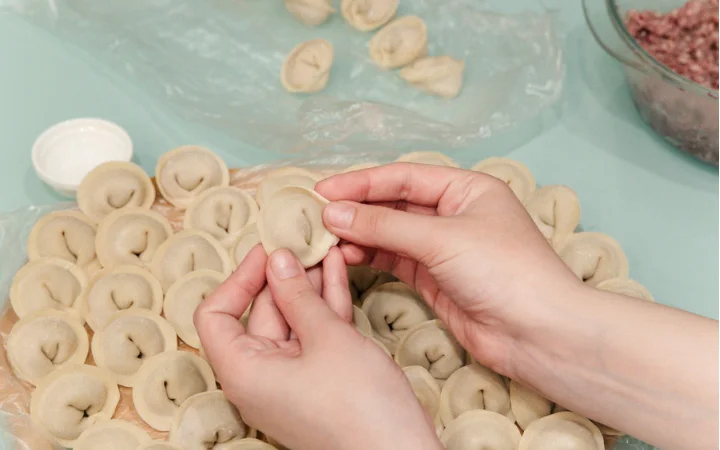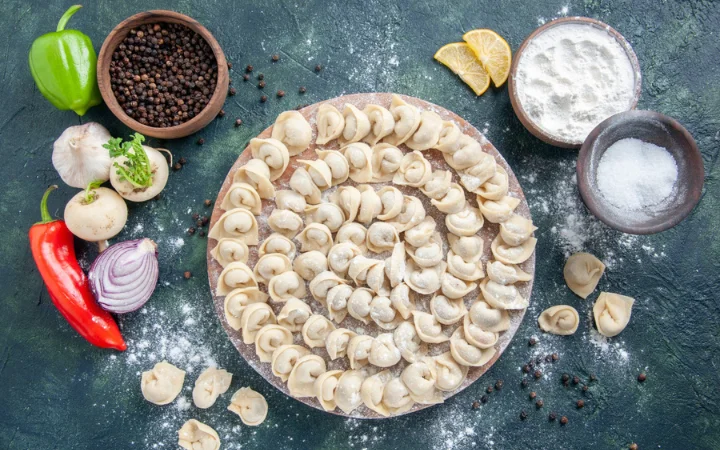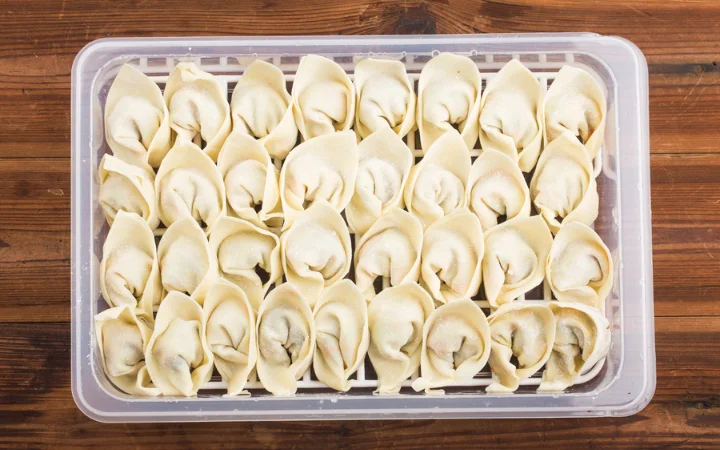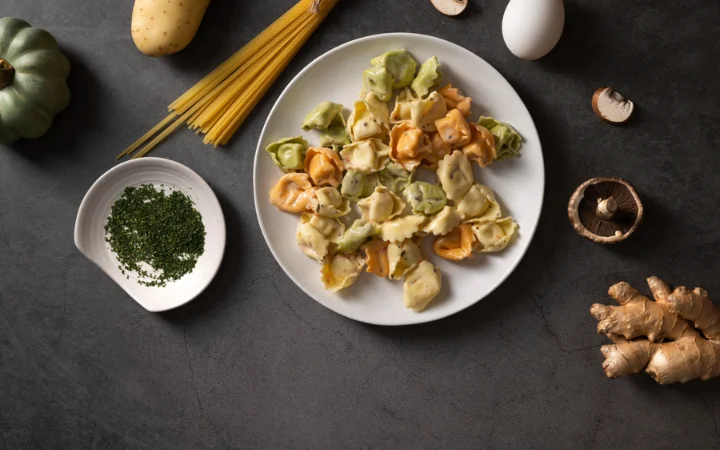Diving into this culinary world, we embark on a journey that spans centuries and crosses borders, bringing a piece of Italian tradition right to our tables. This guide explores the rich history of this beloved pasta, the art of crafting it at home, its versatility in cooking, and its global adaptations. We’ll also navigate the choices of store-bought tortellini and share tips on storing them for optimal freshness. Plus, a dedicated FAQs section will clear up any tortellini-related queries you might have. Whether you’re a seasoned enthusiast or a curious foodie, this comprehensive guide promises to enrich your understanding and appreciation of this Italian classic, ensuring you’re well-equipped to explore its delicious possibilities.
Introduction to Tortellini
The World of Tortellini: An Introduction
These little rings of filled delight are more than just a meal; they’re a bite-sized piece of Italian culture and history. Originating from the Emilia-Romagna region of Italy, it have been a staple of Italian cuisine, embodying the essence of homemade cooking and family traditions. For more on the fascinating history of pasta, including tortellini, visit Wikipedia’s comprehensive overview.
What is Tortellini?
At its core, this pasta variety is known for its distinctive ring shape and the delectable filling hidden within. Traditionally, this filling consists of a mix of meats, such as pork loin, raw prosciutto, and mortadella, blended with Parmigiano Reggiano cheese, eggs, and nutmeg. However, variations abound, with cheese and vegetable fillings offering a vegetarian alternative that’s just as rich in flavor.
The Historical Roots of Tortellini
It’s origins are steeped in legend, with tales dating back to the Middle Ages. One popular story suggests that tortellini was inspired by the navel of Venus, the goddess of love, highlighting the pasta’s connection to beauty and desire. While the true origins may be lost to history, tortellini‘s enduring presence in Italian cooking speaks to its timeless appeal.
Tortellini vs. Tortelloni: Understanding the Difference
While these and their larger counterparts may seem identical at first glance, the devil is in the details—or, in this case, the size and filling. Tortelloni are larger and typically stuffed with a richer variety of fillings, such as ricotta cheese and leafy greens like spinach. This distinction not only highlights the diversity within Italian pasta dishes but also showcases the regional variations and personal touches that make Italian cuisine so beloved.

As we delve deeper into this world, we’ll uncover the secrets to making this exquisite pasta at home, explore its culinary versatility, and celebrate its global journey. So, grab your apron, and let’s get ready to twist, fill, and fold our way through this delightful realm.
Crafting Tortellini at Home
Crafting these from scratch is a rewarding kitchen adventure. For a detailed guide on making homemade pasta, which is the foundation of great tortellini, check out Love and Lemons’ Homemade Pasta Recipe. It lets you dive hands-first into Italian culinary traditions. You’ll mix, knead, roll, and fill your way to delicious, homemade pasta. Let’s break down the process into simple steps.
Essential Ingredients for Homemade Tortellini
First up, gather your ingredients. For the pasta dough, you’ll need flour, eggs, and a pinch of salt. Simple, right? For the filling, get creative. Mix meats or if you want to keep it vegetarian fil it with ricotta and spinach. Don’t forget the Parmigiano Reggiano for that cheesy goodness.
Step-by-Step Guide to Making Tortellini
Now, it’s time to dive in. Start by making a well in the flour and crack the eggs into it. Knead until you’ve got a smooth dough. Then, roll it thin and cut out circles. Place a dollop of filling in each, fold them into half-moons, and twist to form the classic tortellini shape.
Preparing the Filling
Mix your chosen fillings until they’re just right. Balance is key. You want enough flavor without overpowering the delicate pasta.
Shaping and Filling Tortellini
After cutting your dough into circles, add the filling. Then fold, twist, and voila! You’ve made tortellini. It’s a fun process, so get the family involved!
Tips and Tricks for Perfect Tortellini
Here are a few pro tips. Keep your dough covered to prevent drying. Be generous with flour on your work surface to stop sticking. And most importantly, enjoy the process. Making tortellini is about more than just the delicious end product. It’s about embracing the joy of cooking and sharing a piece of Italian tradition.
Crafting it at home might seem daunting at first. But with a bit of patience and practice, you’ll soon be whipping up batches of this beloved pasta like a pro. It’s a fantastic way to bring a taste of Italy into your kitchen and onto your plate. So, why not give it a try?

Cooking with Tortellini
Culinary Adventures with Tortellini
Once you’ve mastered making tortellini, the next step is to cook them to perfection. This versatile pasta shines in a variety of dishes, from soups to salads. Let’s explore some classic and innovative ways to enjoy your homemade pasta.
Classic Tortellini Dishes
A traditional favorite is tortellini in brodo, a simple yet flavorful broth-based soup. Tina’s Table offers an authentic Tortellini in Brodo recipe that brings a piece of Bologna to your kitchen. It highlights the pasta’s delicate taste. For a heartier meal, consider a tortellini bake. Layer your pasta with rich tomato sauce and mozzarella, then bake until bubbly.
Innovative Tortellini Recipes to Try
Feeling adventurous? Toss this pasta with roasted vegetables and pesto for a fresh, vibrant salad. Or, for a fun twist, try deep-frying for a crispy, savory snack. The possibilities are endless.
Tortellini in Brodo
This classic dish is all about simplicity. Simmer your tortellini in a clear, savory broth. It’s comfort food at its finest, perfect for chilly evenings.
Baked Tortellini Casseroles
For a cozy, comforting dish, bake your tortellini with layers of cheese and sauce. It’s a crowd-pleaser that’s sure to satisfy any appetite.
Pairing Sauces
The right sauce can elevate your tortellini to new heights. A classic butter and sage sauce lets the pasta’s flavors shine. For something bolder, try a creamy Alfredo or a spicy arrabbiata. The key is to balance the sauce’s richness with the filling’s flavors.
Cooking with this pasta opens up a world of culinary possibilities. Whether you stick to traditional recipes or experiment with new ideas, this pasta is sure to delight. So, heat up your pots, and let’s bring the taste of Italy to your table with some delicious tortellini dishes.

Tortellini Across Cultures
Tortellini Beyond Borders: A Global Perspective
Interestingly, tortellini has not only captured hearts in Italy but has also found a place in kitchens worldwide. For a taste of how pasta is celebrated globally, explore Taste of Home’s collection of 60 Pasta Recipes from Around the World, showcasing the versatility and universal love for pasta dishes. As it traveled, chefs and home cooks alike have embraced and adapted this pasta, infusing it with local flavors and ingredients. Let’s take a closer look at how tortellini has transformed on its global journey.
Tortellini in Italian Cuisine
In Italy, tortellini remains a cherished dish, often served during special occasions and family gatherings. Traditionally, it’s prepared with a meat-based filling, but variations abound, reflecting Italy’s diverse regional cuisines. For instance, in Bologna, tortellini in brodo is a staple, whereas coastal regions might favor seafood fillings.
Tortellini Adaptations Around the World
As tortellini ventured beyond Italy, it began to reflect the tastes and traditions of its new homes. In the United States, for example, cheese-filled tortellini served with Alfredo or marinara sauce has become popular. Meanwhile, in vegetarian and vegan circles, it’s fillings have evolved to include plant-based ingredients, showcasing the pasta’s versatility.
Moreover, some cultures have introduced tortellini to entirely new flavor profiles, such as using spices and herbs not traditionally found in Italian cuisine. This fusion approach has led to innovative dishes that blend the best of multiple culinary worlds.
The journey of These little rings from a regional Italian specialty to a global favorite is a testament to its adaptability and universal appeal. Whether it’s served in a traditional broth, baked in a casserole, or reimagined with new fillings and sauces, tortellini continues to enchant diners around the world. So, next time you enjoy a plate of tortellini, remember that you’re partaking in a dish that has traveled far and wide, gathering flavors and stories along the way.
Buying and Storing Tortellini
Navigating the World of Store-Bought Options
So, you’ve decided to explore the convenience of store-bought tortellini. While this article focuses on crafting and enjoying it, for more general pasta insights, including storage tips and a variety of recipes that have garnered rave reviews, visit Food Network’s 47 Pasta Recipes with Tons of Glowing, 5-Star Ratings Fortunately, the market offers a wide array of options, from fresh to frozen and dried. Each type has its own merits and can be a great addition to your pantry or fridge. Let’s dive into how to choose the best of it and keep it fresh for your next culinary creation.
Choosing the Right Tortellini: Fresh, Frozen, or Dried
Firstly, when you’re browsing the aisles, consider the dish you’re planning. Fresh tortellini is perfect for when you’re after a tender bite and have a meal in mind soon. On the other hand, frozen version offers a fantastic balance between convenience and quality, ready to be transformed into a delicious dish at a moment’s notice. Lastly, dried version is a pantry staple, boasting a long shelf life and ensuring you’re always prepared for a pasta craving.
Storing Tortellini for Optimal Freshness
Once you’ve made your choice, proper storage is key to maintaining your tortellini‘s freshness. For fresh pasta, keep it in the refrigerator and use it by the best-before date. If you’ve opted for frozen, ensure it stays frozen until you’re ready to cook. Dried tortellini, meanwhile, should stay in a cool, dry place in your pantry.
Best Brands of Tortellini on the Market
Moreover, exploring different brands can lead to delightful discoveries. Some brands specialize in artisanal tortellini, filled with gourmet ingredients, while others focus on creating authentic Italian experiences. Don’t hesitate to try a few to find your favorite.
In conclusion, whether you choose fresh, frozen, or dried version, each offers a pathway to a delicious meal. By selecting the right type for your needs and storing it correctly, you’ll ensure that it is always ready to play the starring role in your next culinary adventure. So, why not stock up on a variety and let your taste buds travel from the comfort of your kitchen?

FAQs
As we’ve explored this culinary world, you might still have questions about this versatile pasta. Here, we’ll address some common queries, providing insights that will help you enjoy tortellini to its fullest. Whether you’re curious about making it vegan or seeking tips for serving, this section has got you covered.
Can it Be Made Vegan?
Absolutely! For those following a plant-based diet, tortellini can easily adapt. Instead of traditional meat or cheese fillings, opt for vegan alternatives like tofu ricotta or a blend of roasted vegetables and nuts. With the right seasonings, vegan tortellini can be just as delicious and satisfying. Explore RecipeTin Eats’ Pesto Pasta for a delightful vegan pesto that can be used to fill your tortellini.
How to Serve it to Impress Your Guests?
To truly impress, consider the presentation and accompaniments. Serve tortellini in a clear, flavorful broth for an elegant starter. Or, mix it with a homemade pesto and fresh cherry tomatoes for a vibrant main course. Don’t forget a side of crusty bread and a well-paired wine to complete the experience.
The Best Ways to Reheat Tortellini
When reheating tortellini, the key is to preserve its texture and flavor. For best results, gently reheat it in a pan with a splash of water or broth, covering it to steam lightly. Avoid microwaving if possible, as it can make the pasta too soft or unevenly heated.
In wrapping up, these FAQs aim to enhance your experience, from crafting vegan versions to serving it up in style. With these tips and tricks, you’re well-equipped to enjoy it in a myriad of ways, ensuring each bite is as delightful as the last. So, go ahead, experiment with confidence, and let These little rings take center stage in your next meal.
Conclusion
In summary, our exploration of tortellini has taken us from its historical origins to its global presence, highlighting the art of making it at home and its culinary versatility. We’ve navigated the choices between fresh, frozen, and dried versions, and provided tips for storage, vegan adaptations, and serving suggestions. Through this journey, we’ve seen that these Stuffed Pasta is not just a pasta but a versatile ingredient that invites creativity and tradition into our meals. Whether homemade or store-bought, tortellini enriches our dining experiences, offering a world of flavors and possibilities to explore.

